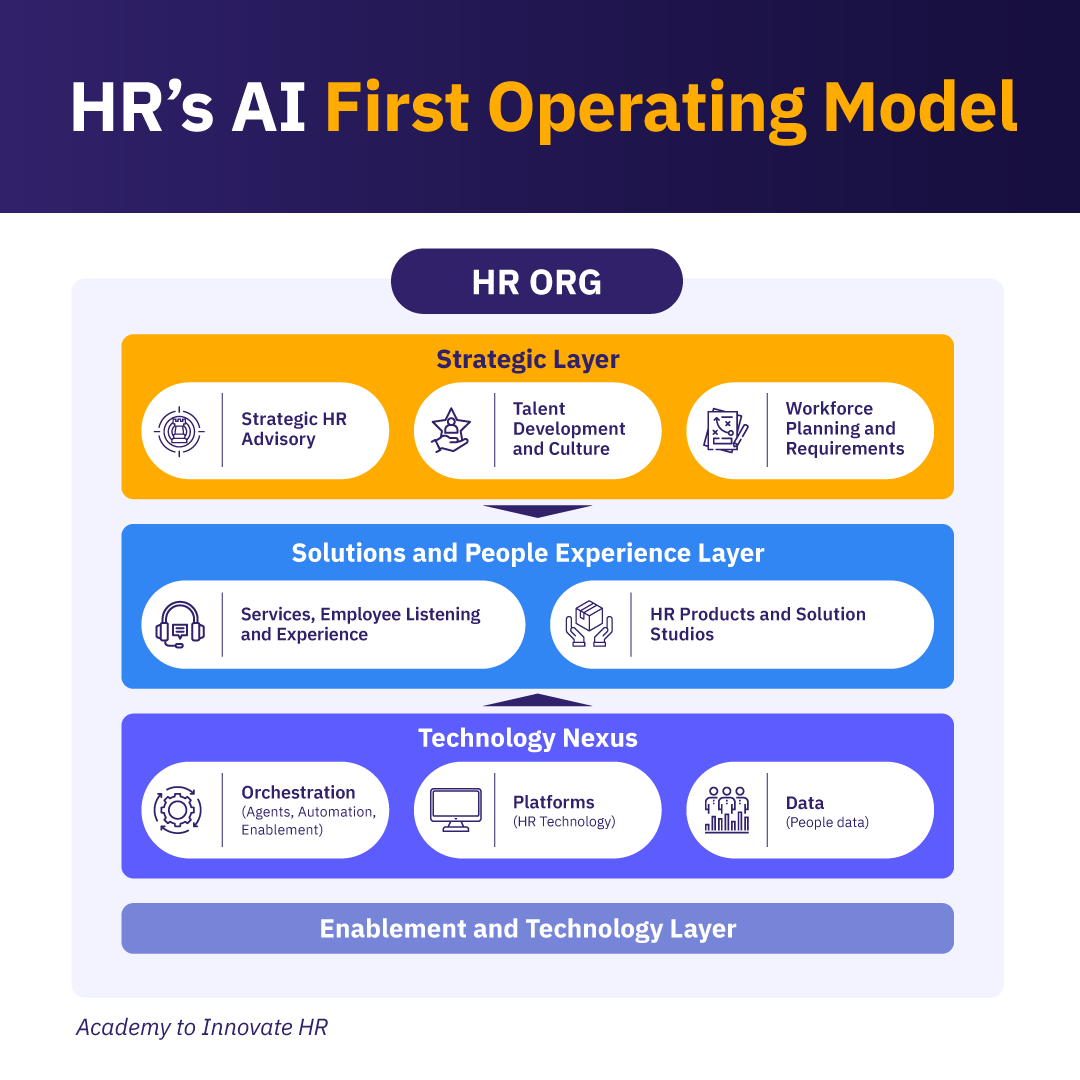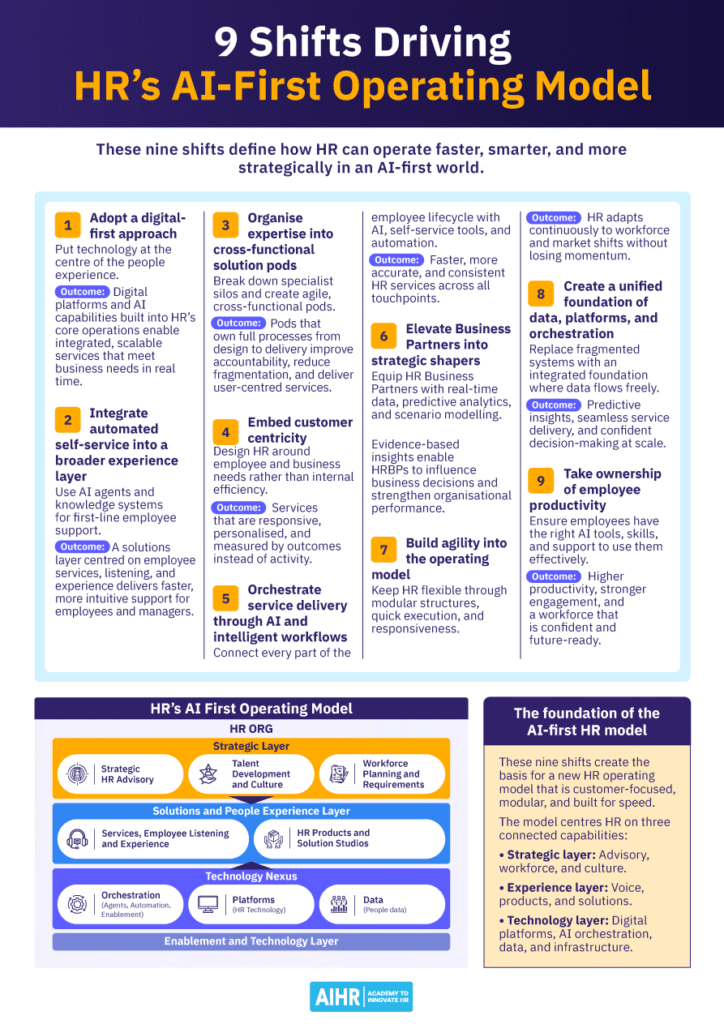In organisations with high AI adoption, 62% say they invest in employee training to scale AI’s impact. Leaders recognise that AI’s value depends on people who can use it.
But capability building alone isn’t enough. Most HR functions still operate on operating models designed for process efficiency, rather than intelligence. The long-standing structure of business partners, centres of excellence, and shared services once enabled consistency and scale.
These legacy models slow decision-making, fragment data, and make it difficult to embed AI into everyday work. This constrains HR’s ability to adapt, make data-driven decisions, and move at the speed of change.
AI is rewriting how HR creates value
Administrative work is being replaced by intelligent agents that resolve employee requests in real time. Specialists are no longer buried in isolated teams; they collaborate in agile pods that combine data, technology, and human insight. At the same time, advisory roles are supported by predictive analytics that guide decisions instead of reacting to them.
At AIHR, we see this shift first-hand in our advisory work with HR leaders building AI-enabled functions. The lesson is consistent: organisations realise AI’s potential only when they redesign the HR operating model so that technology strengthens, rather than replaces, human expertise.
This article outlines the essential design principles of an AI-first HR operating model and how to structure the function for speed, intelligence, and measurable business impact. We also share from our work with leading organisations how to put these principles into practice.
9 shifts driving HR’s AI-first operating model
To realise the potential of AI in HR, organisations must move beyond automating existing processes. Optimisation alone is not enough. HR needs to rethink its purpose, how it operates, and how it partners with the business.
Previous technology waves, such as cloud computing and robotics, often made HR faster but not fundamentally different. AI requires a complete redesign of how work happens and how HR creates value.
The following nine shifts define the principles of an AI-first operating model. They enable quicker decisions, more personalised experiences, and stronger strategic impact.
1. Adopt a digital-first approach
Put technology at the centre of the people experience. When HR builds digital platforms and AI capabilities into its core operations, it can deliver integrated and scalable services that respond to business needs in real time.
2. Integrate automated self-service into a broader experience layer
AI agents and knowledge systems now handle many first-line employee requests. They sit within a solutions layer focused on employee services, listening, and experience. This approach speeds up support and creates a more intuitive interaction for employees and managers.
3. Organise HR expertise into cross-functional solution pods
An AI-first function breaks down specialist silos. HR expertise resides in agile, cross-functional teams that own the entire process from design to delivery. These pods improve accountability, reduce fragmentation, and deliver user-centred services.
4. Embed customer centricity
Traditional HR models prioritised internal efficiency. An AI-first model starts with the needs of employees and the business. It designs services that are responsive, personalised, and measured by outcomes rather than activity.
5. Orchestrate service delivery through AI and intelligent workflows
AI agents, self-service tools, and automated workflows now connect every part of the employee lifecycle. This integration allows HR to provide faster, more accurate, and consistent service at every touchpoint.
6. Elevate business partners into strategic shapers
With real-time data, predictive analytics, and scenario modelling, HR Business Partners move from coordinating processes to shaping strategy. They use evidence-based insights to influence business decisions and strengthen organisational performance.
7. Build agility into the operating model
An AI-first HR function must stay flexible. Modular structures, quick execution, and a focus on responsiveness allow HR to adjust to workforce and market changes without losing momentum.
8. Create a unified foundation of data, platforms, and orchestration
Disconnected systems and fragmented data weaken AI’s impact. HR needs a single, integrated foundation where data flows freely across platforms. This foundation supports predictive insight, seamless service delivery, and confident decision-making.
9. Take ownership of employee productivity
As AI becomes part of everyday work, HR must ensure employees have the tools, skills, and support to use it effectively. By working with IT and embedding enablement into the employee experience, HR helps people use AI confidently and productively.
These nine shifts create the foundation for a new HR operating model that is customer-focused, modular, and built for speed. Instead of refining the traditional three-part structure, this model re-centres HR on three connected capabilities:
- A strategic layer focused on advisory, workforce, and culture.
- An experience layer focused on voice, products, and solutions.
- A technology layer that connects digital platforms, AI orchestration, data, and infrastructure.
The next section explores how these capabilities work together to deliver greater impact, scalability, and alignment between HR and business strategy.
An AI-first HR operating model
The AI-first HR operating model serves as a blueprint for structuring HR to create meaningful impact. Instead of organizing around legacy functions or process silos, it brings HR’s strategic advisory, employee solutions, and enabling technologies together into one coherent system.
At its core, the model connects strategy, experience, and technology through three integrated layers. This structure enables HR to act as a unified function that delivers personalized services, uses real-time insights, and shapes business outcomes at scale.
1. The strategic layer
The strategic layer ensures that HR’s direction and priorities align with the organisation’s goals. It focuses on three areas:
- Strategic HR advisory: Guiding leaders on people decisions that drive business performance today and in the future.
- Talent development and culture: Building the skills, mindsets, and culture needed for future success.
- Workforce planning and requirements: Aligning workforce capabilities with business demand and external trends.
This layer defines HR’s long-term direction and ensures that every HR initiative supports organisational success and responds to market developments.
2. The solutions and people experience layer
The solutions and people experience layer turns strategy into real, day-to-day experiences for employees. It has two key components:
- Services, employee listening, and experience: Focuses on how employees engage with HR and ensures their feedback shapes continuous improvement.
- HR products and solution pods: Design, deliver, and refine HR solutions that meet both business and employee needs.
3. The enablement and technology layer
The enablement and technology layer forms the foundation of the entire operating model. At its centre is the technology nexus, which connects HR systems, data, and automation into one seamless environment. The Nexus integrates three essential enablers:
- Platforms and infrastructure: The systems and applications that HR teams and employees rely on every day.
- People data: The insights and analytics that guide evidence-based decisions.
- Orchestration: The automation, intelligent agents, and enablement capabilities that link everything together to create smooth digital experiences.
Together, these three layers form an HR operating model built for an AI-first world. The integration of strategy, experience, and technology enables HR to act as a single, intelligent system, one that learns, adapts, and drives tangible business results.

Examples of the AI-First HR operating model in action
Example 1: Driving wellbeing in the workplace
Attrition among high-potential employees has increased, particularly in hybrid work environments. Leaders want to address wellbeing and retention proactively rather than reactively.
How the AI-driven operating model would respond:
Strategic layer:
HR’s strategic advisory identifies retention as a priority business risk. Workforce Planning highlights key roles with high turnover risk. The Culture function works on embedding psychological safety and wellbeing into leadership practices.
Solutions and people experience layer:
The employee listening and experience center deploys continuous pulse surveys and digital feedback channels, detecting early signals of burnout or disengagement. The Solutions Pods design targeted interventions based on this data (e.g., hybrid work support programs, manager coaching for empathy, flexible career pathways).
Enablement and technology layer:
The technology nexus turns the wellbeing strategy into a set of data-driven and technology-supported initiatives:
- Platforms: Integrated wellbeing apps and career mobility tools provide employees with resources at their fingertips.
- People data: Predictive analytics flag flight risks among key employee groups and surface the primary drivers of turnover, giving HR and managers proactive alerts and actionable insights.
- Orchestration: AI-driven workflows automatically recommend wellbeing check-ins, connect employees to career advisors, or suggest job rotation opportunities based on patterns
Example 2: Driving data-led succession practices
A regional bank faces looming retirements in its senior leadership team, including the CFO and Head of Risk. The Board is concerned about continuity, regulatory compliance, and developing internal successors rather than relying solely on external hires. HR is responsible for ensuring a robust, data-driven succession plan for critical roles.
How the AI-driven operating model would respond:
Strategic layer
- Strategic HR advisory works with the CEO and Board to define succession planning as a top governance and business continuity priority.
- Workforce planning and requirements analyzes upcoming retirements, identifies “mission-critical” roles, and projects leadership capability needs for the next 3–5 years.
- Culture and talent development ensure succession is tied to leadership development programs, embedding future-focused capabilities (e.g., digital fluency, adaptive leadership) into readiness assessments.
Solutions and people experience layer
- The employee listening and experience center collects insights from leadership 360° feedback, employee perception surveys, and engagement data, helping HR identify hidden leadership talent and employee trust in succession processes.
- HR products & solution pods design tailored leadership acceleration programs, including stretch assignments, job rotations, and mentoring by outgoing leaders. They also co-create transparent career pathways to strengthen employee confidence in succession fairness.
Enablement and technology layer
- Platforms and infrastructure: AI-powered talent marketplaces highlight high-potential employees, suggest developmental opportunities, and flag career moves that would accelerate readiness.
- People data: Predictive analytics map internal successors against readiness levels (for example, ready now, ready in 1–3 years, etc.), while external talent benchmarks provide context for hiring decisions.
- Orchestration: Automated workflows remind leaders to update succession profiles, generate development action plans for successors, and schedule Board updates. Intelligent agents surface “flight risk” alerts for high-potentials, triggering proactive retention measures.
Transitioning to an AI-first HR operating model
The AI-first HR operating model marks a decisive break from the past. When technology, data, and orchestration sit at the core, HR moves from being a service provider to becoming a strategic driver of organizational performance.
This model is not about replacing people with machines. It is about amplifying human impact. AI frees HR from transactional work, equips it with predictive insights, and enables faster, more personalized solutions at scale.
Redesigning how HR works
The transition demands a redesign of established processes, legacy systems, and ingrained ways of working. Many organisations will operate in a hybrid state for some time, where traditional structures coexist with emerging AI-driven capabilities..
Change will occur through progressive steps, including the introduction of intelligent self-service tools, piloting conversational agents, and embedding predictive analytics into HR business partnering. These initiatives build momentum, demonstrate value, and create the confidence to expand adoption more broadly.
Developing new skills and capabilities
Equally critical is the human side of transformation. HR professionals will need to develop new skills in digital agility, data literacy, and AI fluency, while leaders will have to reimagine roles and manage the cultural shift that comes with automation.
Business leaders and employees also need to understand what HR aims to achieve through this new model. Organisations should adjust HR’s mandate, scope, and responsibilities so that the function can focus on what matters most: using AI to advance a more human-centric and value-driven purpose.
Making the model a reality
Transitioning to an AI-first HR operating model requires a balance of bold ambition and practical action. Organisations that succeed will not only streamline operations but also expand HR’s strategic influence.
An AI-first function is faster, smarter, and more impactful, yet remains grounded in human experience. By embracing this change with intent and discipline, HR can strengthen its position as a true strategic partner, ready to lead in a digital, data-driven world.










